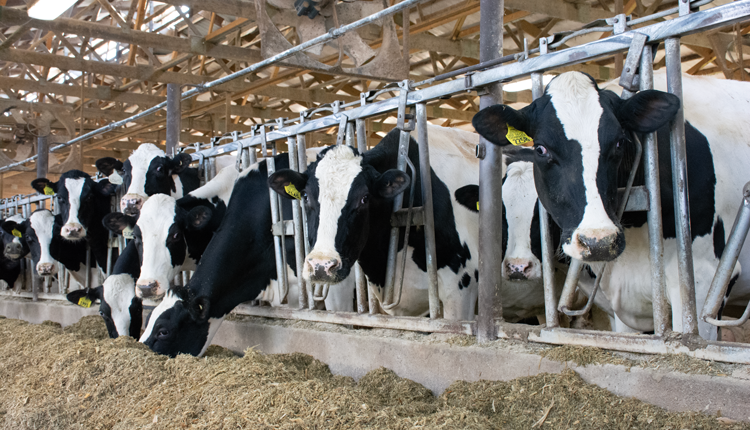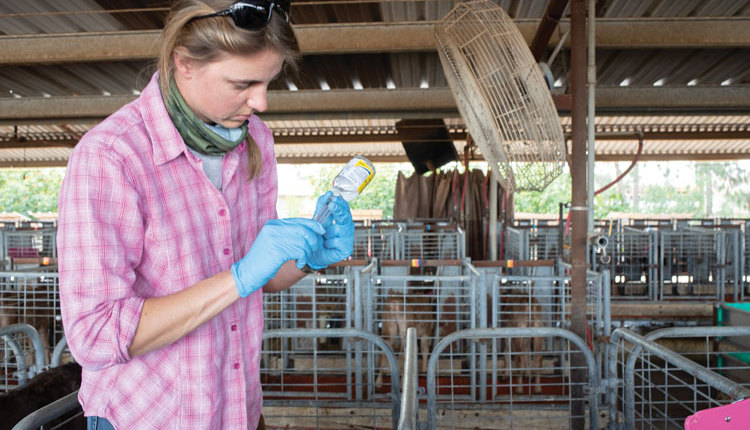This article is from the website of NMC, a global organization for mastitis control and milk quality. See nmconline.org. It was adopted from the University of Illinois extension veterinarian, Dick Wallace, D.V.M.
When a cow needs medication, the first treatment step (before any medications are administered) should be the application of some form of semi-permanent identification. You should use at least two different identification methods. These may include leg bands, chalk marks, tail tape, neck chains, or some other form of secure identification that can be removed easily when the withholding time has expired.
• When FDA-approved drugs (for dry and lactating cows) are used according to the label directions, you should follow the recommended withholding times. Extensive product evaluations by drug manufacturers have built safety factors (required by the FDA) into the established withholding times. These safety factors are 100 to 1,000 times lower than the lowest dose expected to cause a violative residue in milk.
Drugs used in an extra-label manner MUST be used within the context of a valid veterinarian-client-patient relationship. Extra-label treatments DO NOT have established withdrawal times. Therefore, the prescribing veterinarian must supply a withdrawal time for meat and milk sufficient to assure food safety. Administering two or more FDA drugs into one cow at the same time is considered extra-label drug use.
Extra-label use also includes changing the dosage and frequency or route of administration, and may result in violative residue. Even though FDA-approved medications are used according to label directions, extended withholding times may be needed for cows that calve earlier than expected, cows that are severely ill, or cows that do not respond to label treatments.
• Milking all treated cows AFTER untreated herdmates is an important preventive measure and strongly advised. Milk dump-buckets connected to pipeline vacuum can overflow or be tipped, allowing contaminated milk to enter the system.
• Although milk residue tests are not designed or approved for individual cow testing, milk from all purchased cows should be evaluated for residues by a test kit that detects the same drugs as the farm's milk processor. This should occur before commingling purchased-cow milk in the bulk tank. It may be prudent to discard milk from purchased additions for at least eight milkings regardless of milk residue test results.
• Using the same milking unit on treated and untreated cows without thoroughly cleaning and sanitizing between cows is a violation of the Pasteurized Milk Ordinance. Extremely small quantities of contaminated milk can result in bulk tank residues.
• Segregate treated cows from lactating cows, preferably in a separate facility. Physical isolation will reduce the potential for unintentional commingling of treated dry cows with the lactating herd. The farm specific, two-way identification system mentioned previously should make it simple for the people milking to easily recognize antibiotic-treated cows.
• Prior to milking, hang a treated cow list from the bulk tank swing line. Temporary parlor (milking) downtime should occur between milking untreated herdmates and treated cows. Even if untreated cows remain in the parlor as "place holders," all milking units should be removed and readied for the medicated milking string. To retrieve the treated-cow list from the swing line, you must enter the milk house. Before removing the treated-cow list, pull the swing line out of the bulk tank. Use the treated-cow list to cross-check the remaining cows to ensure that all treated cows have been withheld.
• The practice of using medicated foot baths to control hoof diseases has some scientific basis. Once manure accumulates in the foot bath solution, the efficacy of the medication may be reduced dramatically. Consider treating individual lame cows with sprays, corrective hoof trims, or both to reduce the potential for residues.
• Don't use medicated feeds to control diseases in lactating cows.
• All FDA-approved drugs designed for intramammary use will be absorbed into a cow's bloodstream after infusion into a quarter. Discard milk from all four quarters, regardless of which quarter was treated.
Ten common reasons antibiotic contamination occurs in bulk tank milk*
When a cow needs medication, the first treatment step (before any medications are administered) should be the application of some form of semi-permanent identification. You should use at least two different identification methods. These may include leg bands, chalk marks, tail tape, neck chains, or some other form of secure identification that can be removed easily when the withholding time has expired.
• When FDA-approved drugs (for dry and lactating cows) are used according to the label directions, you should follow the recommended withholding times. Extensive product evaluations by drug manufacturers have built safety factors (required by the FDA) into the established withholding times. These safety factors are 100 to 1,000 times lower than the lowest dose expected to cause a violative residue in milk.
Drugs used in an extra-label manner MUST be used within the context of a valid veterinarian-client-patient relationship. Extra-label treatments DO NOT have established withdrawal times. Therefore, the prescribing veterinarian must supply a withdrawal time for meat and milk sufficient to assure food safety. Administering two or more FDA drugs into one cow at the same time is considered extra-label drug use.
Extra-label use also includes changing the dosage and frequency or route of administration, and may result in violative residue. Even though FDA-approved medications are used according to label directions, extended withholding times may be needed for cows that calve earlier than expected, cows that are severely ill, or cows that do not respond to label treatments.
• Milking all treated cows AFTER untreated herdmates is an important preventive measure and strongly advised. Milk dump-buckets connected to pipeline vacuum can overflow or be tipped, allowing contaminated milk to enter the system.
• Although milk residue tests are not designed or approved for individual cow testing, milk from all purchased cows should be evaluated for residues by a test kit that detects the same drugs as the farm's milk processor. This should occur before commingling purchased-cow milk in the bulk tank. It may be prudent to discard milk from purchased additions for at least eight milkings regardless of milk residue test results.
• Using the same milking unit on treated and untreated cows without thoroughly cleaning and sanitizing between cows is a violation of the Pasteurized Milk Ordinance. Extremely small quantities of contaminated milk can result in bulk tank residues.
• Segregate treated cows from lactating cows, preferably in a separate facility. Physical isolation will reduce the potential for unintentional commingling of treated dry cows with the lactating herd. The farm specific, two-way identification system mentioned previously should make it simple for the people milking to easily recognize antibiotic-treated cows.
• Prior to milking, hang a treated cow list from the bulk tank swing line. Temporary parlor (milking) downtime should occur between milking untreated herdmates and treated cows. Even if untreated cows remain in the parlor as "place holders," all milking units should be removed and readied for the medicated milking string. To retrieve the treated-cow list from the swing line, you must enter the milk house. Before removing the treated-cow list, pull the swing line out of the bulk tank. Use the treated-cow list to cross-check the remaining cows to ensure that all treated cows have been withheld.
• The practice of using medicated foot baths to control hoof diseases has some scientific basis. Once manure accumulates in the foot bath solution, the efficacy of the medication may be reduced dramatically. Consider treating individual lame cows with sprays, corrective hoof trims, or both to reduce the potential for residues.
• Don't use medicated feeds to control diseases in lactating cows.
• All FDA-approved drugs designed for intramammary use will be absorbed into a cow's bloodstream after infusion into a quarter. Discard milk from all four quarters, regardless of which quarter was treated.
Ten common reasons antibiotic contamination occurs in bulk tank milk*
- Milk from a treated cow was accidentally routed into the pipeline.
- An antibiotic-treated dry cow was unintentionally milked.
- The same milking unit was used to milk an antibiotic-treated cow before milking untreated cows. The milking unit was not cleaned and sanitized between uses.
- Lactating cows were purchased, and the new owner was unaware of recent antibiotic treatments prior to sale.
- One quarter of a cow was treated for mastitis and withheld from the bulk tank. However, milk from the other three quarters was NOT withheld and was permitted to enter the pipeline.Equipment used to milk treated cows was handled carelessly; for example, vacuum from the milk pipeline was used to operate dump-milk buckets.
- All antibiotic-treated dry cows were milked last, but the milk line was not diverted from the bulk tank.
- Antibiotic residues remained in the milk of a cow that was treated in an extra-label fashion. These are the cows which should be tested individually.
- Medicated feed was accidentally mixed into the lactating-cow feed.
- Cows drank from a medicated foot bath.
*Supported by the Minnesota Department of Agriculture Dairy and Food Inspection Division, the University of Minnesota, College of Veterinary Medicine, Department of Clinical and Population Sciences, the Minnesota Milk Producer's Association, and the Minnesota Veterinary Medical Association.
100510_360







